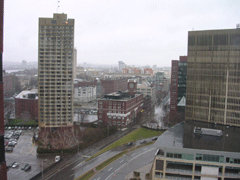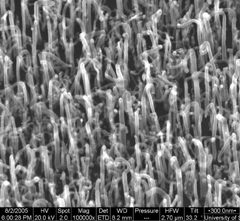Few Rules on Nanotech
Air Date: Week of August 1, 2008

Cambridge, Massachusetts, is the third U.S. city to debate regulating nanotechnology. (Photo: Rick Umali)
As questions continue to grow about nanotechnology's potential dangers, so do concerns about how the small stuff should be regulated. Reporter Jeff Young continues Living on Earth's series "Let's Get Small" with a look at why federal agencies have yet to meet the regulatory challenge. Then Living on Earth's Mitra Taj takes us to Cambridge, Massachusetts, where lack of federal action has left the city to figure out what to do with nano in its own backyard.
Transcript
GELLERMAN: It’s Living on Earth, I’m Bruce Gellerman. Businesses based on the science of very small things - nanotechnology - are booming. But as tiny materials become commonplace in consumer products their use raises big questions about health and safety. Today we continue with a series of stories about nanotechnology we call “Let’s Get Small” - with a look at the problems government agencies large and small face regulating nanomaterials. We have two reports: coming up – how cities are trying to get a handle on nanotechnology. But first our Washington correspondent Jeff Young explains why there are still no federal rules governing the growing nanotech industry.
YOUNG: Down at the nano scale - a billionth of a meter - things can get weird. Scientists who study nano materials like to tell a little story about that, the story of the shrinking cat. Here’s how Andrew Maynard at the Woodrow Wilson International Center for Scholars tells it:
MAYNARD: Imagine you take a cat and you can shrink that cat to make it smaller…
[SOUND OF A CAT MEOWING]
MAYNARD: - and smaller…
[FAINTER MEW]
MAYNARD: And smaller…
[VERY FAINT MEW]
MAYNARD: And you look at it and it looks small but it still looks like a cat, still sounds like a cat, still smells like a cat. But then imagine you get to a point where you shrink it down and all of a sudden…
[WOOF, BARKING NOISE]
MAYNARD: It turns into a dog. Absolutely incredible behavior! You wouldn’t believe it would happen. But nanotechnology is just like that. It does the same thing as changing from cat into a dog. So this is something where the chemistry doesn’t change, you’ve still got the same atoms there, but the behavior changes radically at the nano scale.
YOUNG: That points to what’s so promising and perplexing about nanomaterials. They could soon revolutionize manufacturing and medicine. But when otherwise ordinary materials behave in unexpected ways they throw a tiny monkey wrench into our system for keeping products safe. Maynard’s research found one example of this: Carbon nanotubes, which are already in products from car parts to tennis rackets. Maynard and other researchers noticed that some carbon nanotubes in long fibers seemed a lot like another well-known fiber - asbestos.

Too small to be seen by the naked eye, each of these carbon nanotubes measures about 40 nanometers (or 400 atoms) across. (Photo: St Steve)
YOUNG: But chemically Carbon nanotubes are still just carbon - the same as the graphite in your pencil. And that’s the little monekywrench. Much of our current system for regulating hazards is based on the chemical makeup of the material in question. But with nanomaterials, it’s size that matters.
[NOISE OF A CROWDED ROOM]
MODERATOR: We’re going to try to get started…
YOUNG: Policy advisors and scientists packed a recent meeting at Washington’s Woodrow Wilson Center to learn more about the nanotech challenge to the regulatory system. Terry Davies, a senior fellow at the Washington think tank Resources for the Future, told them current federal safeguards are not up to the job.
DAVIES: The protection is completely inadequate in terms of assuring public that nanomaterials are safe even those kinds of nanomaterials that people us on their bodies or that they swallow or whatever - in baby rattles and teething rings all bunch of things like that - there is no government oversight with regard to health and safety.
YOUNG: Davies recommends much more safety research funding. He says the Food and Drug Administration should have more authority over cosmetics and dietary supplements. And he says laws on toxic substances should expand to let regulators look beyond chemistry for potential hazards. But those changes are complicated, partly because there are two dozen federal agencies involved. It is Clayton Teague’s job to keep them straight. Teague directs the National Nanotechnology Coordination office. He says each agency is clarifying how to apply existing rules. But they want to know more
before considering any new regulations.
TEAGUE: Once we truly have adequate info about any potential hazards this may happen. But I think to do so without adequate scientific information would just be inappropriate.
YOUNG: Critics say the government isn’t getting the information it needs.
DENISON: Unfortunately the steps taken to learn more are also quite weak.
YOUNG: That’s Richard Dennison, with the advocacy group Environmental Defense Fund. Dennison says the Environmental Protection Agency used a voluntary approach when asking companies to share data on nano materials they’re working with. Only 13 companies submitted full information.
DENNISON: Agencies are unwilling to use authority they have even to get better info so we_re not even getting up the learning curve.
YOUNG: Dennison and other environmentalists are working with industry to better gauge nanotech risks and build a framework for new rules and guidelines. You might expect business to resist anything that might lead to new regulations. But business consultant Matthew Nordan, at the firm Lux Research, surveyed nanotech companies and found that wasn’t the case.
NORDAN: Surprisingly companies want to be regulated when it comes to nanotechnology. They are more concerned about the risk of under regulation than overregulation. The most common refrain is if I’m going to go out on the field and participate in the game—I want to know what the rules are.
YOUNG: Nordan says companies hope clear rules will soothe jittery investors and insurers. But so far there’s a lot of talk about regulation, but little action. And it looks like a clear set of rules from the federal government will not come anytime soon. That leaves nanotech companies and the communities that host them to try figure things out on their own.
I’m Jeff Young in Washington.

Cambridge, Massachusetts is the third U.S. city to debate regulating nanotechnology. (Photo: Rick Umali)
[MUSIC FROM JUGGLERS]
TAJ: Last May, the Museum of Science in Boston teamed up with its neighbor Cambridge to teach the general public about what's known - and isn't known - about nanotechnology.
NANO BROTHERS: Ladies and gentlemen, boys and girls, you have a once in a lifetime opportunity, to be the first audience to witness the finest nano juggling show ever known.
TAJ: The amazing nano brothers taught the audience the basics - while juggling pins, rings, footballs - and houseplants. For the grand finale, they juggled products containing carbon nanotubes, tennis rackets, baseball bats -
[JUGGLING SOUNDS]
TAJ: All while riding seven-foot-tall unicycles.
NANO BROTHERS: Yeah, they did it!
[APPLAUSE]
TAJ: The city of Cambridge has also been juggling nanotechnology - trying to balance its potential benefits with possible risks.
ALPERT: We were dealing with an emerging science and technology that's emerging all over the globe in research laboratories, and there are a lot of unknowns.

The Amazing Nano Brothers perform at the Museum of Science. Helping educate the general public about nanotech is part of Cambridge’s response to the growing use of nanotechnology in the city. (Photo: Todd A. Carpenter)
ALPERT: How do you go to a research lab and say I want to know how much of this and and this and this you have when everybody makes their nano-materials from a different process?
TAJ: So how do you regulate the unknown?
[CITY COUNCIL AMBIENCE]
TAJ: Cambridge decided that you DON'T - at least.... not yet.
[CITY COUNCIL AMBIENCE]
[VOICE: "... this meeting to order”]
TAJ: At a recent city council meeting, Cambridge city manager Robert Healy presented the taskforce's recommendations: for now, the city isn't requiring companies to disclose usage of nano-scale materials, but it is asking them to.
HEALY: ...Nano very potentially is the wave of the future so it’s dangerous not to watch it but it's dangerous to stifle it.

Businesses and organizations working with nanotechnology in and around Cambridge, Massachusetts (Photo: NanoMetro Map, Courtesy of the Project on Emerging Technologies)
LERER: As many potential benefits as there are to nanotechnology, there are also great risks. And to cut industry loose and focus just on the one side of the nanotechnology that doesn't address the risks, we feel would be socially irresponsible.
TAJ: But Terrence Smith of the Cambridge Chamber of Commerce says the city doesn't want to scare away industries that use nanotechnology - especially when they're already being cautious.
SMITH: Cambridge is an expensive place to do business, so if you've made the choice to be here you've made a significant investment. If you do something wrong, that hurts you in your bottom line. And I have a fair amount of confidence that the people working with these materials are well-trained.
TAJ: Some city officials are less confident. Councilwoman Henrietta Davis praised the city's decision not to regulate nanotech, but says she still has concerns.
DAVIS: Most of the nano stuff that's going on here is at Harvard and MIT, where I think in the university setting, they're very - potentially very careful.
TAJ: Every two years, city health officials will update the Cambridge council on the state of nanotech regulation and research. Sam Lipson, from the Public Health Department says there's still a lot to learn.
LIPSON: Maybe the quality of the questions is the best outcome - maybe that's the most valuable product we're producing because clearly we can’t answer most of them but it may help us look in the right direction.
TAJ: Whatever decisions end up being made - or not made - at the federal level, Cambridge is leaving the door open to regulating nanotechnology in its own backyard.
For Living on Earth, I'm Mitra Taj.
GELLERMAN: For more information about our series on nanotechnology, “Let’s get Small” – go to our website, loe.org. And while you’re at it – let us know what you think about these stories – or others you hear on the show. You can Call our listener line at 800-218-9988. That's 800-218-99-88. Or write to 20 Holland Street, Somerville, Massachusetts, 02144. Our e-mail address is letters at l-o-e dot org. Once again, letters at l-o-e dot o-r-g.
Links
Maynard et. al. study on carbon nanotubes
Report by Ray Davies on nanotechnology regulations
The National Nanotechnology Initiative on government oversight
The Cambridge Nanomaterials Advisory Committee’s recommendations to city council
Living on Earth wants to hear from you!
Living on Earth
62 Calef Highway, Suite 212
Lee, NH 03861
Telephone: 617-287-4121
E-mail: comments@loe.org
Newsletter [Click here]
Donate to Living on Earth!
Living on Earth is an independent media program and relies entirely on contributions from listeners and institutions supporting public service. Please donate now to preserve an independent environmental voice.
NewsletterLiving on Earth offers a weekly delivery of the show's rundown to your mailbox. Sign up for our newsletter today!
 Sailors For The Sea: Be the change you want to sea.
Sailors For The Sea: Be the change you want to sea.
 Creating positive outcomes for future generations.
Creating positive outcomes for future generations.
 Innovating to make the world a better, more sustainable place to live. Listen to the race to 9 billion
Innovating to make the world a better, more sustainable place to live. Listen to the race to 9 billion
 The Grantham Foundation for the Protection of the Environment: Committed to protecting and improving the health of the global environment.
The Grantham Foundation for the Protection of the Environment: Committed to protecting and improving the health of the global environment.
 Contribute to Living on Earth and receive, as our gift to you, an archival print of one of Mark Seth Lender's extraordinary wildlife photographs. Follow the link to see Mark's current collection of photographs.
Contribute to Living on Earth and receive, as our gift to you, an archival print of one of Mark Seth Lender's extraordinary wildlife photographs. Follow the link to see Mark's current collection of photographs.
 Buy a signed copy of Mark Seth Lender's book Smeagull the Seagull & support Living on Earth
Buy a signed copy of Mark Seth Lender's book Smeagull the Seagull & support Living on Earth

